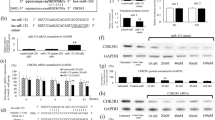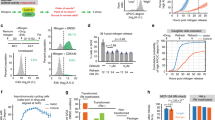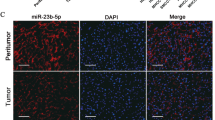Abstract
Disruption of contact inhibition and serum afflux that occur after a tissue injury activate cell cycle, which then stops when confluence is reached again. Although the events involved in cell cycle entry have been widely documented, those managing cell cycle exit have remained so far ill defined. We have identified that the final stage of wound closure is preceded in keratinocytes by a strong accumulation of miR-483-3p, which acts as a mandatory signal triggering cell cycle arrest when confluence is reached. Blocking miR-483-3p accumulation strongly delays cell cycle exit, maintains cells into a proliferative state and retards their differentiation program. Using two models of cell cycle synchronization (i.e. mechanical injury and serum addition), we show that an ectopic upregulation of miR-483-3p blocks cell cycle progression in early G1 phase. This arrest results from a direct targeting of the CDC25A phosphatase by miR-483-3p, which can be impeded using an anti-miRNA against miR-483-3p or a protector that blocks the complex formation between miR-483-3p and the 3′-untranslated region (UTR) of CDC25A transcript. We show that the miRNA-induced silencing of CDC25A increases the tyrosine phosphorylation status of CDK4/6 cyclin-dependent kinases which, in turn, abolishes CDK4/6 capacity to associate with D-type cyclins. This prevents CDK4/6 kinases’ activation, impairs downstream events such as cyclin E stimulation and sequesters cells in early G1. We propose this new regulatory process of cyclin-CDK association as a general mechanism coupling miRNA-mediated CDC25A invalidation to CDK post-transcriptional modifications and cell cycle control.
Similar content being viewed by others
Log in or create a free account to read this content
Gain free access to this article, as well as selected content from this journal and more on nature.com
or
Abbreviations
- CDK:
-
cyclin-dependent kinase
- CKI:
-
CDK inhibitor
- FCS:
-
fetal calf serum
- KRT:
-
keratin
- LNA:
-
locked nucleic acid
- LOI:
-
loss of imprinting
- miRNA:
-
microRNA
- mRNA:
-
messenger RNA
- NHK:
-
Normal human keratinocytes
- NICD:
-
Notch intracellular domain
- siRNA:
-
short interfering RNA
- UTR:
-
untranslated region
References
Schafer M, Werner S . Cancer as an overhealing wound: an old hypothesis revisited. Nat Rev Mol Cell Biol 2008; 9: 628–638.
Sherr CJ, Roberts JM . Living with or without cyclins and cyclin-dependent kinases. Genes Dev 2004; 18: 2699–2711.
Bueno MJ, Malumbres M . MicroRNAs and the cell cycle. Biochim Biophys Acta 2011; 1812: 592–601.
Rissland OS, Hong SJ, Bartel DP . MicroRNA destabilization enables dynamic regulation of the miR-16 family in response to cell-cycle changes. Mol Cell 2011; 43: 993–1004.
Johnson CD, Esquela-Kerscher A, Stefani G, Byrom M, Kelnar K, Ovcharenko D et al. The let-7 microRNA represses cell proliferation pathways in human cells. Cancer Res 2007; 67: 7713–7722.
Lee SO, Masyuk T, Splinter P, Banales JM, Masyuk A, Stroope A et al. MicroRNA15a modulates expression of the cell-cycle regulator Cdc25A and affects hepatic cystogenesis in a rat model of polycystic kidney disease. J Clin Invest 2008; 118: 3714–3724.
Yang X, Feng M, Jiang X, Wu Z, Li Z, Aau M et al. miR-449a and miR-449b are direct transcriptional targets of E2F1 and negatively regulate pRb-E2F1 activity through a feedback loop by targeting CDK6 and CDC25A. Genes Dev 2009; 23: 2388–2393.
Wang P, Zou F, Zhang X, Li H, Dulak A, Tomko RJ et al. microRNA-21 negatively regulates Cdc25A and cell cycle progression in colon cancer cells. Cancer Res 2009; 69: 8157–8165.
Pothof J, Verkaik NS, van IW, Wiemer EA, Ta VT, van der Horst GT et al. MicroRNA-mediated gene silencing modulates the UV-induced DNA-damage response. EMBO J 2009; 28: 2090–2099.
Shi L, Zhang J, Pan T, Zhou J, Gong W, Liu N et al. MiR-125b is critical for the suppression of human U251 glioma stem cell proliferation. Brain Res 2010; 1312: 120–126.
Sarkar S, Dey BK, Dutta A . MiR-322/424 and -503 are induced during muscle differentiation and promote cell cycle quiescence and differentiation by down-regulation of Cdc25A. Mol Biol Cell 2010; 21: 2138–2149.
Marcet B, Chevalier B, Luxardi G, Coraux C, Zaragosi LE, Cibois M et al. Control of vertebrate multiciliogenesis by miR-449 through direct repression of the Delta/Notch pathway. Nat Cell Biol 2011; 13: 693–699.
Bertero T, Gastaldi C, Bourget-Ponzio I, Imbert V, Loubat A, Selva E et al. miR-483-3p controls proliferation in wounded epithelial cells. FASEB J 2011; 25: 3092–3105.
Ferland-McCollough D, Fernandez-Twinn DS, Cannell IG, David H, Warner M, Vaag AA et al. Programming of adipose tissue miR-483-3p and GDF-3 expression by maternal diet in type 2 diabetes. Cell Death Differ 2012; 19: 1003–1012.
Hao J, Zhang S, Zhou Y, Hu X, Shao C . MicroRNA 483-3p suppresses the expression of DPC4/Smad4 in pancreatic cancer. FEBS Lett 2011; 585: 207–213.
Ozata DM, Caramuta S, Velazquez-Fernandez D, Akcakaya P, Xie H, Hoog A et al. The role of microRNA deregulation in the pathogenesis of adrenocortical carcinoma. Endocr Relat Cancer 2011; 18: 643–655.
Veronese A, Lupini L, Consiglio J, Visone R, Ferracin M, Fornari F et al. Oncogenic role of miR-483-3p at the IGF2/483 locus. Cancer Res 2010; 70: 3140–3149.
Veronese A, Visone R, Consiglio J, Acunzo M, Lupini L, Kim T et al. Mutated beta-catenin evades a microRNA-dependent regulatory loop. Proc Natl Acad Sci U S A 2011; 108: 4840–4845.
Turchi L, Chassot AA, Rezzonico R, Yeow K, Loubat A, Ferrua B et al. Dynamic characterization of the molecular events during in vitro epidermal wound healing. J Invest Dermatol 2002; 119: 56–63.
Chassot AA, Lossaint G, Turchi L, Meneguzzi G, Fisher D, Ponzio G et al. Confluence-induced cell cycle exit involves pre-mitotic CDK inhibition by p27(Kip1) and cyclin D1 downregulation. Cell Cycle 2008; 7: 2038–2046.
Kitagawa M, Higashi H, Jung HK, Suzuki-Takahashi I, Ikeda M, Tamai K et al. The consensus motif for phosphorylation by cyclin D1-Cdk4 is different from that for phosphorylation by cyclin A/E-Cdk2. EMBO J 1996; 15: 7060–7069.
Takaki T, Fukasawa K, Suzuki-Takahashi I, Semba K, Kitagawa M, Taya Y et al. Preferences for phosphorylation sites in the retinoblastoma protein of D-type cyclin-dependent kinases, Cdk4 and Cdk6, in vitro. J Biochem 2005; 137: 381–386.
Mazars A, Fernandez-Vidal A, Mondesert O, Lorenzo C, Prevost G, Ducommun B et al. A caspase-dependent cleavage of CDC25A generates an active fragment activating cyclin-dependent kinase 2 during apoptosis. Cell Death Differ 2009; 16: 208–218.
Choi WY, Giraldez AJ, Schier AF . Target protectors reveal dampening and balancing of Nodal agonist and antagonist by miR-430. Science 2007; 318: 271–274.
Iavarone A, Massague J . Repression of the CDK activator Cdc25A and cell-cycle arrest by cytokine TGF-beta in cells lacking the CDK inhibitor p15. Nature 1997; 387: 417–422.
Jinno S, Hung SC, Okayama H . Cell cycle start from quiescence controlled by tyrosine phosphorylation of Cdk4. Oncogene 1999; 18: 565–571.
Martin NG, McAndrew PC, Eve PD, Garrett MD . Phosphorylation of cyclin dependent kinase 4 on tyrosine 17 is mediated by Src family kinases. FEBS J 2008; 275: 3099–3109.
Boutros R, Dozier C, Ducommun B . The when and wheres of CDC25 phosphatases. Curr Opin Cell Biol 2006; 18: 185–191.
Ray D, Kiyokawa H . CDC25A levels determine the balance of proliferation and checkpoint response. Cell Cycle 2007; 6: 3039–3042.
Boutros R, Lobjois V, Ducommun B . CDC25 phosphatases in cancer cells: key players? Good targets? Nat Rev Cancer 2007; 7: 495–507.
Fernandez-Vidal A, Mazars A, Manenti S . CDC25A: a rebel within the CDC25 phosphatases family? Anticancer Agents Med Chem 2008; 8: 825–831.
Zimmerman WC, Erikson RL . Polo-like kinase 3 is required for entry into S phase. Proc Natl Acad Sci USA 2007; 104: 1847–1852.
Endicott JA, Noble ME, Tucker JA . Cyclin-dependent kinases: inhibition and substrate recognition. Curr Opin Struct Biol 1999; 9: 738–744.
Bartova I, Otyepka M, Kriz Z, Koca J . Activation and inhibition of cyclin-dependent kinase-2 by phosphorylation; a molecular dynamics study reveals the functional importance of the glycine-rich loop. Protein sci 2004; 13: 1449–1457.
Welburn JP, Tucker JA, Johnson T, Lindert L, Morgan M, Willis A et al. How tyrosine 15 phosphorylation inhibits the activity of cyclin-dependent kinase 2-cyclin A. J Biol Chem 2007; 282: 3173–3181.
Stepanova L, Leng X, Parker SB, Harper JW . Mammalian p50Cdc37 is a protein kinase-targeting subunit of Hsp90 that binds and stabilizes Cdk4. Genes Dev 1996; 10: 1491–1502.
Matsushime H, Quelle DE, Shurtleff SA, Shibuya M, Sherr CJ, Kato JY . D-type cyclin-dependent kinase activity in mammalian cells. Mol Cell Biol 1994; 14: 2066–2076.
Paternot S, Bockstaele L, Bisteau X, Kooken H, Coulonval K, Roger PP . Rb inactivation in cell cycle and cancer: the puzzle of highly regulated activating phosphorylation of CDK4 versus constitutively active CDK-activating kinase. Cell Cycle 2010; 9: 689–699.
Zhao Q, Boschelli F, Caplan AJ, Arndt KT . Identification of a conserved sequence motif that promotes Cdc37 and cyclin D1 binding to Cdk4. J Biol Chem 2004; 279: 12560–12564.
Sonkoly E, Wei T, Janson PC, Saaf A, Lundeberg L, Tengvall-Linder M et al. MicroRNAs: novel regulators involved in the pathogenesis of psoriasis? PLoS ONE 2007; 2: e610.
Joyce CE, Zhou X, Xia J, Ryan C, Thrash B, Menter A et al. Deep sequencing of small RNAs from human skin reveals major alterations in the psoriasis miRNAome. Hum Mol Genet 2011; 20: 4025–4040.
Kong D, Piao YS, Yamashita S, Oshima H, Oguma K, Fushida S et al. Inflammation-induced repression of tumor suppressor miR-7 in gastric tumor cells. Oncogene 2012; 31: 3949–3960.
Wang W, Zhao LJ, Tan YX, Ren H, Qi ZT . MiR-138 induces cell cycle arrest by targeting cyclin D3 in hepatocellular carcinoma. Carcinogenesis 2012; 33: 1113–1120.
Wang W, Zhao LJ, Tan YX, Ren H, Qi ZT . Identification of deregulated miRNAs and their targets in hepatitis B virus-associated hepatocellular carcinoma. World J Gastroenterol 2012; 18: 5442–5453.
Yi C, Wang Q, Wang L, Huang Y, Li L, Liu L et al. MiR-663, a microRNA targeting p21(WAF1/CIP1), promotes the proliferation and tumorigenesis of nasopharyngeal carcinoma. Oncogene 2012; 31: 4421–4433.
Olson P, Lu J, Zhang H, Shai A, Chun MG, Wang Y et al. MicroRNA dynamics in the stages of tumorigenesis correlate with hallmark capabilities of cancer. Genes Dev 2009; 23: 2152–2165.
Guled M, Lahti L, Lindholm PM, Salmenkivi K, Bagwan I, Nicholson AG et al. CDKN2A, NF2, and JUN are dysregulated among other genes by miRNAs in malignant mesothelioma -A miRNA microarray analysis. Genes Chromosomes Cancer 2009; 48: 615–623.
Doghman M, Wakil AE, Cardinaud B, Thomas E, Wang J, Zhao W et al. Regulation of insulin-like growth factor-mammalian target of rapamycin signaling by microRNA in childhood adrenocortical tumors. Cancer Res 2010; 70: 4666–4675.
Dulic V, Stein GH, Far DF, Reed SI . Nuclear accumulation of p21Cip1 at the onset of mitosis: a role at the G2/M-phase transition. Mol Cell Biol 1998; 18: 546–557.
Acknowledgements
This work was supported by funds from the Association pour la Recherche sur le Cancer (ARC, Grant 5420). Thomas Bertero was a recipient of a doctoral contract from the Ministry of Higher Education and Research. Cécile Gastaldi was a recipient of a fellowship from INSERM/PACA region.
Author information
Authors and Affiliations
Corresponding authors
Ethics declarations
Competing interests
The authors declare no conflict of interest.
Additional information
Edited by RA Knight
Supplementary Information accompanies the paper on Cell Death and Differentiation website
Supplementary information
Rights and permissions
About this article
Cite this article
Bertero, T., Gastaldi, C., Bourget-Ponzio, I. et al. CDC25A targeting by miR-483-3p decreases CCND–CDK4/6 assembly and contributes to cell cycle arrest. Cell Death Differ 20, 800–811 (2013). https://doi.org/10.1038/cdd.2013.5
Received:
Revised:
Accepted:
Published:
Issue date:
DOI: https://doi.org/10.1038/cdd.2013.5
Keywords
This article is cited by
-
ZNF703 promotes triple-negative breast cancer cells through cell-cycle signaling and associated with poor prognosis
BMC Cancer (2022)
-
FA-SAT ncRNA interacts with PKM2 protein: depletion of this complex induces a switch from cell proliferation to apoptosis
Cellular and Molecular Life Sciences (2020)
-
Long noncoding RNA gastric cancer-related lncRNA1 mediates gastric malignancy through miRNA-885-3p and cyclin-dependent kinase 4
Cell Death & Disease (2018)
-
CyclinD-CDK4/6 complexes phosphorylate CDC25A and regulate its stability
Oncogene (2017)
-
H19 lncRNA regulates keratinocyte differentiation by targeting miR-130b-3p
Cell Death & Disease (2017)



